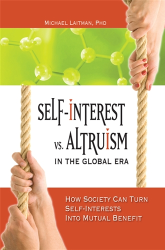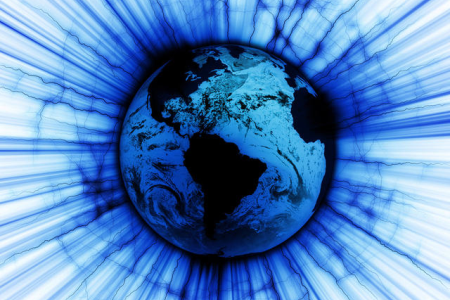Why You Must Understand How Global Interdependence & Global Crisis Interconnect
When the worst financial crisis since the Great Depression first broke out in August of 2008, many politicians and financiers in key positions emphasized the need for unity and cooperation. They voiced a need to restrain the egocentric frame of mind dominating Wall Street and expressed a fear of separatist and protectionist tendencies. Headlines such as The Economic Times’ “World Leaders Seek Unity to fight financial Crisis” prevailed in newspapers all over the world, signaling a general willingness to unite and cooperate in the face of economic uncertainty.
At first glance, this spirit is understandable, if not called for. After all, the world’s financiers knew that their institutions were linked together so tightly that if one failed, the others would follow, and politicians were warned that if they did not bail out the banks in their countries, their own economies would collapse, precipitating a domino effect that would bring down the entire global economy.
However, in the face of a crisis, it is natural to do the opposite of uniting: close yourself off and protect what is yours. This seems like a safer route than joining forces with “foreigners,” especially when those foreigners may be regarded as culprits or, at least, contributors to the making of your plight.
For politicians, it would seem more natural to put their own countries first, as with the British Corn Laws tariffs of the 19th century and President Hoover’s 1933 “Buy American” Act. Yet, as the delicate balance of cooperation and self-interest teeters back and forth, we survey the destruction wrought by the financial crisis and find that the majority of voices champion unity and denounce protectionism and separation. Why is this so?
If we consider this question from a purely economic or psychological aspect, we will not arrive at a conclusive answer. However, when we view it from the perspective of the science of Kabbalah, we will see that the forces involved in international relations, and indeed in any relations, are forces of integration, not of isolation. They are far more powerful than any rational or irrational decision-making process, and determine our moves “behind the scenes.”
On the international level, these forces determine global trade, politics, treaties, conflicts, and ecology. On the national level, they determine the trends in education, welfare policy, media, and local economy. On the personal level, they determine our relationships with our families, and on the deepest level of existence, they determine evolution—ours and that of every other element in Nature.
To understand the forces and elements that create reality and stir it in its course, we must first come to know their origins and their final destinations. Otherwise, trying to understand reality is like trying to grasp the inner workings of a car—its engine, the engine’s connection to the gear, the way the gear shifts the power to the wheels, and so on—without explaining that a car is a machine built to transport people safely, comfortably, and quickly from place A to place B. Without explaining the car’s purpose, what good is any discussion of its structure?
The Secret to Reality Even Cutting Edge Physicists Haven’t Found Yet
Like science, Kabbalah researches the inner workings of reality. But unlike science, which observes phenomena and offers theories as to their end goal, Kabbalah sees the goal first and from there explains the structure. That goal, as explained by Kabbalah, is for every person in the world to discover the single, fundamental force that creates and governs all of life. In other words, the goal of Kabbalah is for every person to discover life’s creative force, obtain it, and reap all the benefits this discovery implies.
Kabbalah is certainly not the only science ever to research Nature’s hidden forces that operate our world behind the scenes. According to Encyclopedia Britannica, “Newton’s theory of mechanics, known as classical mechanics, accurately represented the effects of forces under all conditions known in his time. … the theory has since been modified and expanded by the theories of quantum mechanics and relativity.” In other words, to make a gross generalization, in the 20th century science was no longer satisfied with Newton’s theory because it was insufficient to explain all of Nature’s observed phenomena.
In the second half of the 20th century, scientists realized that the new theories, too, fell short of explaining all of Nature’s phenomena. This prompted a search for a Grand Unified Theory (GUT). “The dream of theorists [in physics],” according to Encyclopedia Britannica, “Is to find a totally unified theory—a theory of everything, or ToE.”
In what seems like a parallel to the quest for the ToE, many prominent theoretical physicists have begun to posit that at the most fundamental level, we—and all parts of reality—are actually one. Pioneering theoretical physicist Werner Heisenberg said, “There is a fundamental error in separating the parts from the whole, the mistake of atomizing what should not be atomized. Unity and complementarity constitute reality.”
Yet, proving that all parts of reality are manifestations of a single whole, or developing a ToE that applies to all parts of reality, would require a paradigm that works on all levels of life— physical, mental, and intellectual. And here, physicists are out of their purview. Even the most cutting edge theoretical physicists cannot explain all of Nature’s observed phenomena.
You Don’t Have to be a Mystic to Understand & Experience the Oneness of Reality
Certainly, it would be very nice to believe in this perfect picture of oneness, unity, and interconnection among all things. But as eloquent as philosophers may be, a genuine seeker of truth would hardly accept an idea merely because it “sounds” beautiful or true. At the end of the day, the only truly valid test for a theory or concept is one’s personal experience.
After all, what seems valid and true for one may seem completely false to another. If you project a ray of light through a prism, it will separate the light into all the colors of the rainbow. But if the person you show it to is a monochromat (totally colorblind), it will make no difference what names you give to those shades of gray that he or she will see. To that person, they will all be grays. Similarly, as right as physicists and philosophers may be in their observations on the oneness and indivisibility of reality, to accept this oneness as fact, people must experience it for themselves.
While experiencing the oneness of reality may sound mystical to many, the above quotes prove that many proponents of this view are revered scientists, some even Nobel laureates. In fact, the need for a more complete and uniform picture of reality did not arise with the advent of quantum physics, or even with Einstein. Back in 1879, English chemist and physicist, William Crookes, declared, “We have actually touched the borderland where matter and force seem to merge into one another … I venture to think that the greatest scientific problems of the future will find their solution in this borderland, and even beyond; here, it seems to me, lie ultimate realities, subtle, far-reaching, wonderful.”
Indeed, as explained above, Kabbalah observes the end goal first, and from there explains the structure. And because reality is the vehicle by which to achieve this goal, Kabbalah is inherently a Grand Unified Theory, a Theory of Everything, allowing us to both understand the full scope of reality and to actually experience its oneness.
 “Now You Can Understand the Grand Unified Theory of Everything” is based on the book, Self Interest vs. Altruism in the Global Era: How Society Can Turn Self Interests into Mutual Benefit by Dr. Michael Laitman.
“Now You Can Understand the Grand Unified Theory of Everything” is based on the book, Self Interest vs. Altruism in the Global Era: How Society Can Turn Self Interests into Mutual Benefit by Dr. Michael Laitman.

